Managing Files
UPDATED: Find Empty Media Folders v2.0
For macOS 10.15 and later. This applet will traverse the Media folder looking for and displaying any sub-folders that are either empty or that do not contain Media-apps-playable media, such as text or image files.
Free to use in Demo Mode: While in Demo Mode, several convenient features will be disabled, including
- Show Finder Information Window
- Reveal in Finder
- Send to Trash
- Select all Empty/non-Empty
- Scan other user-selected folder
Also see Media Folder Files Not Added.
To purchase a registration code, download and launch the app. Click "Register..." in its File menu and follow the prompts to purchase a code for $2.99. When your payment is processed, you will be emailed a registration code that will unlock the Demo Mode restrictions.
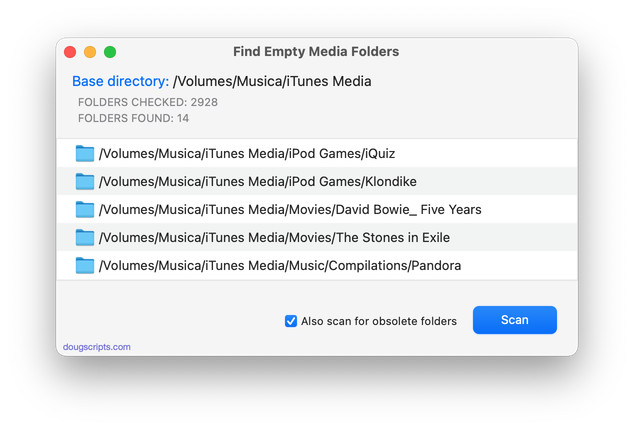
Latest version:
- Accommodations for macOS 10.15 Catalina
- Performance and security enhancements
More information for Find Empty Media Folders v2.0 and download link is here.
UPDATED: Media Folder Files Not Added v1.3
For macOS 10.15 Catalina or later. This application will list the file paths of the media files in your designated "Media" folder which are not associated with any tracks in the Music or TV app's' track library. Additionally, you can select a different parent folder and its contents will be compared to the current library. Includes options to Export a text file listing the file paths, Filter within results, Add a selection of found files to Music or TV, and move them to the Trash. The latter two features are only available in the registered version.
Also see Super Remove Dead Tracks and List MIAs.
To purchase a registration code and remove these restrictions, download and launch the app. Click "Register..." in its File menu and follow the prompts to purchase a code for $2.99. When your payment is processed, you will receive a registration code that will unlock the inhibited features.
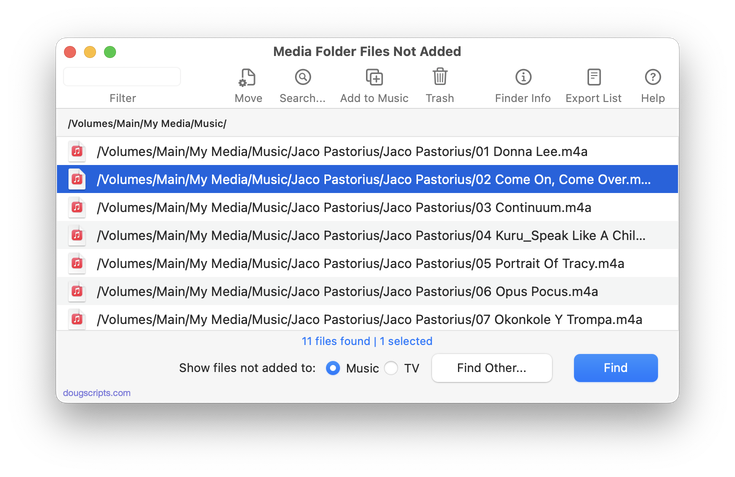
Latest version:
- Adds support for the TV app
- Speed improvements
- v1.2:
- Fixes invalid parameter issue at launch
- v1.1:
- Fixes unusual issue when quit
- v1.0:
- Initial release for Catalina
More information for Media Folder Files Not Added v1.3 and download link is here.
UPDATED: Copy From Start to Stop v3.0
Makes a copy of the selected track using its Start and Stop times as the beginning and ending of the new file and adds to Library, with option to name new track/file. If using with file tracks, NOTE: you may experience some degradation of audio quality if you re-encode a file (one which has already been encoded), and thus the quality of your copy may be a matter of taste. Mileage will vary.
Also see Player Position to Start or Stop and Reset Tracks Start-Stop.
Latest version:
- Accommodations for macOS 10.15 Catalina
- Performance and security enhancements
More information for Copy From Start to Stop v3.0 and download link is here.
List MIAs v5.0
I have combined the utility of Super Remove Dead Tracks and List MIAs into a single script applet and Super Remove Dead Tracks is the runner-up in this contest.
The newest version of List MIAs for the Music app will not only display information about the files no longer associated with tracks in the library, it can also delete those "dead" tracks, which is what Super Remove Dead Tracks did (and can still do if you're using iTunes).
For the purposes of illustration, I Trashed some files for this screenshot:
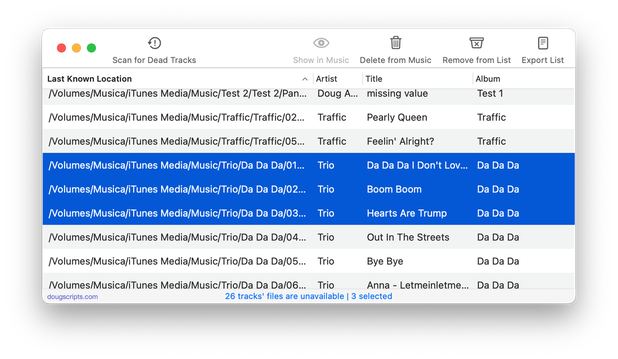
That column on the left displays where Music thought I last left each file; but those files don't exist anywhere because I've already emptied the Trash. Now, I can have List MIAs simply delete all or a selection of those tracks.
List MIAs is free to use in Demo Mode, during which several features will be disabled: Delete Dead Tracks from Music, Reveal Selected Track in Music, Toggle Scan at Launch and performing a scan more than once per launch are inhibited. A registration code to unlock these features is US$2.99.
More information and download is here.
UPDATED: Music Folder Files Not Added v6.0
Music Folder Files Not Added has been updated to v6.0. This application will list the file paths of the media files in your designated "iTunes Media" folder which are not associated with any tracks in iTunes' track library. Additionally, you can select a different parent folder and its contents will be compared to the iTunes library. Includes options to Filter results, Add a selection of found files to iTunes, move them to the Trash, and Export a text file listing the file paths.
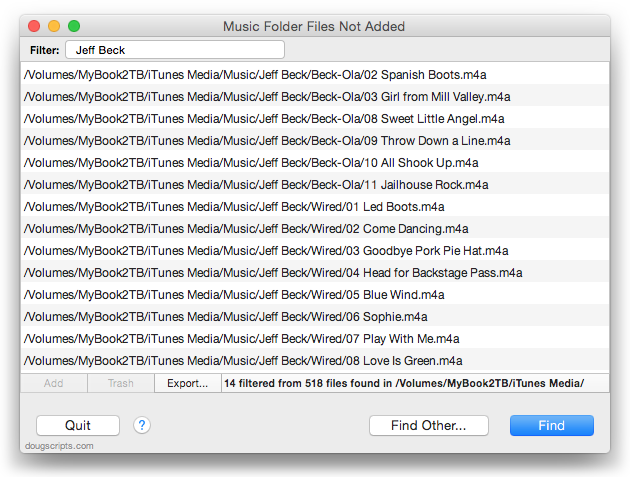
I was getting some reports from users who were getting false positives, so I tweaked the text normalization routines in the hopes of minimizing ambiguous results. Other minor issues were addressed as well.
You can use Music Folder Files Not Added free for ten days, after which a registration can be purchased for $1.99. More information, a video demo and download is available on this page. Current users can "Check for Update..." in the applet's main menu.
Do Some (Very) Rough Audio Editing in iTunes
This is not a tip for everyone.
You may be aware that Apple added some editing capabilities to Quick Look. For instance, Markup is available to edit text and image documents and Trim is available to edit video and audio files.
Using the script Have a Quick Look, a track can be selected in iTunes and its file displayed in a Quick Look window, via the qlmanage command:
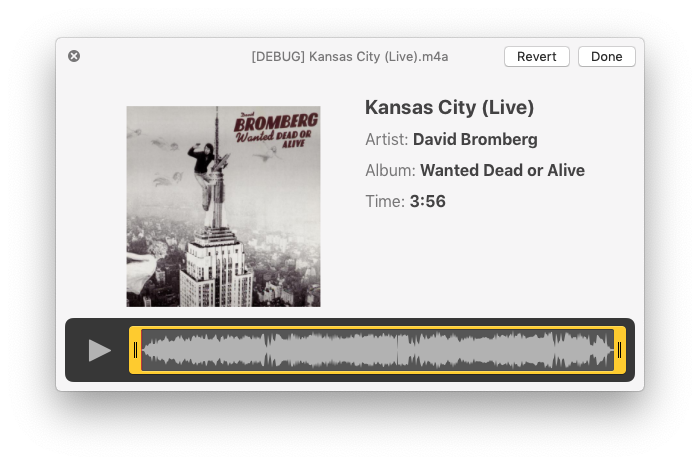
The scrub/trim area becomes available after clicking the Trim button which initially appears in the upper-right corner of the window.
If this suggests to the suggestible reader that this makes a handy audio editor, think twice: editing this way is not very precise and accepted changes are permanent. But, for trimming large audio files of "dead air" or crowd noise or what have you, some may find it convenient.
Some More About Re-Ripping
After my last post about re-ripping CDs, it occurred to me that I should do some re-ripping myself. So, as discussed in the post, I was able to confirm that iTunes does warn you about tracks you've already ripped (tracks with the same Song Name, Artist and Album) and then offers to "Replace Existing".
However, it only tells you this after you've engaged "Import CD" and advanced past the encoder settings dialog. I would much prefer to be aware of these tracks and any potential anomalies before engaging the rip so I can make any alterations to accommodate more efficient ripping. For instance, what file type, bit and sample rates are these already ripped tracks? How many of them are there? Are there any duplicates?
(Another good question is: Did I change the metadata of any tracks I previously ripped from this CD? Those will be harder to find, especially if the Album and/or Artist tags have been changed; iTunes will not consider those tracks a match for any on the CD. The tag info could have been changed by your own hand, or, if it's been several years since you've inserted the CD, Gracenote could have supplied different tag info. I've had this happen.)
Since I know iTunes will offer to "Replace Existing" if it finds library tracks with the same Song Name, Artist and Album I will want to see any of those. And here's a script that tries to find them and offers to wrangle them into a discrete playlist for further investigation:
Re-Ripping FYI
Those of us who may still rip/re-rip a CD or two in iTunes from time to time may see this dialog:
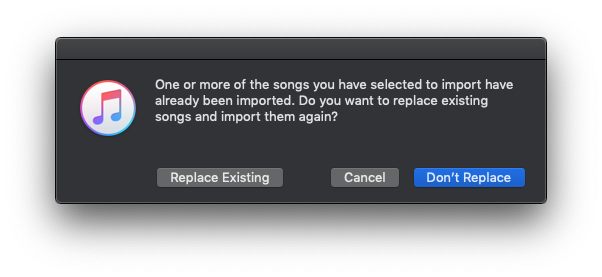
I heard from a user today who wanted to replace a bunch of MP3s with new Apple Lossless copies. But he was afraid that selecting to "Replace Existing" would erase the tags he had meticulously created for the original MP3s.
iTunes uses the Song Name, Artist and Album of each CD track and looks for a track in the iTunes library with tags that match. If a match is found, then you will see the dialog above. And then if you select to "Replace Existing", you are essentially replacing the file and not the track entry itself; that is, the newly ripped-CD track's file replaces the original MP3 file pointed to by the track entry and the other track entry data remains the same (except for obvious changes due to the change of file, like size and file kind and so on).
If one or more of the Song Name, Artist and Album is different then you won't be asked to replace any tracks and the CD tracks will be imported as "new" tracks, perhaps as duplicates.
Rather than allow iTunes to make these decisions, here's a trick. Before importing, copy some tag data from the original tracks in the library to the corresponding CD tracks using Copy Tag Info Tracks to Tracks.
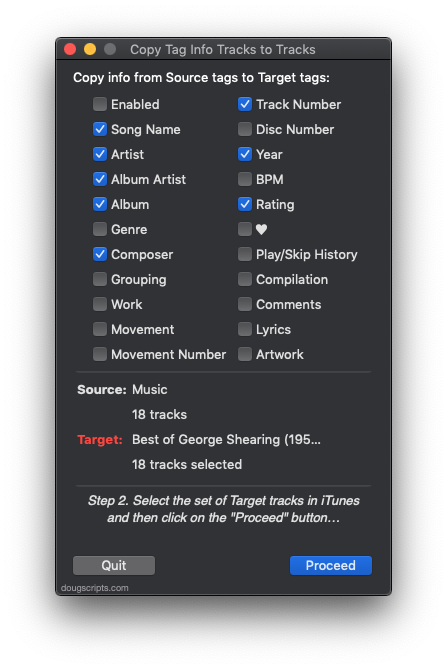
You probably only need to copy Song Name, Artist and Album. But any additional tags wouldn't hurt either.
(Also, see this article at the German site unhyped.de which describes the technique as well.)
Then, when you import the CD, you'll probably now see the "already been imported" dialog from whence you can select "Replace Existing" to correctly replace the original files and keep the existing track entry data.
Exporting Voice Memos
A Correspondent asked how to deal with Voice Memos when the Voice Memo track in iTunes is named using the text that was entered after recording it and its associated file is named using a date and time format. Specifically, he wanted to offload and archive some of the recordings but was concerned that the filenames were not sufficient to describe the contents of the file. Could the track name be transferred to the filename?
The script File Renamer is ostensibly for renaming a track's file in-place. But it can also be used to rename a copy of a file which can be saved to a user-chosen folder.
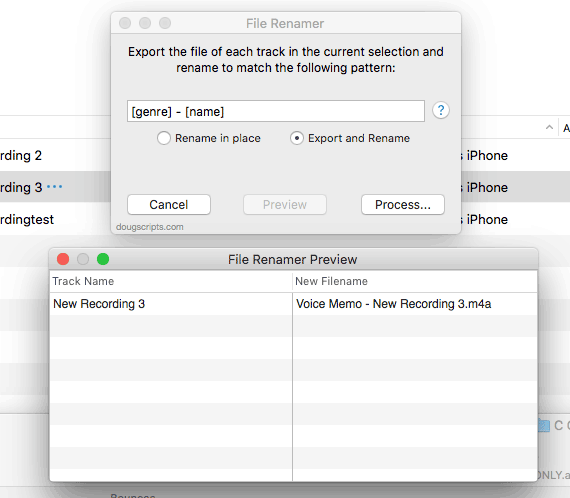
In this case, the Voice Memos have already been sync'd to iTunes from the iPhone. I've selected a single Voice Memo track in the screenshot, but batches are acceptable as well.
I originally named the Voice Memo "New Recording 3". But the filename of the selected track is something like "20180105 060425.m4a", indicating that I recorded it on January 5, 2018 a little after 6AM. File Renamer will create a copy of the file and name it "Voice Memo - New Recording 3.m4a" using the genre and name tags of the track, as well as some additional separator text. The original file remains unaffected.
BTW: I wasn't able to find a specific Voice Memos playlist in iTunes. (Was there ever one? I'm not a Voice Memos Guy.) So I created my own with a Smart Playlist matching all media where Media Kind is Voice Memo.
For more sophisticated offloading options, you may also want to try M3Unify.
Dropbox Dropping Support for Older OSs Soon
I just got an email from Dropbox letting me know that as of November 3, new installations of Dropbox will be no longer be possible on macOS 10.6 (Snow Leopard), 10.7 (Lion) and 10.8 (Mountain Lion) and Windows Vista. Then, on January 17, 2018, support for these OSs will be discontinued entirely. There is more here at Dropbox's site.
I know some iTunes users like to store their libraries in Dropbox (which I don't think is a great idea, but there it is) so if you've got media files on an older machine using Dropbox you may want to move that stuff out of there.
